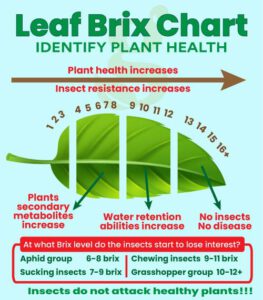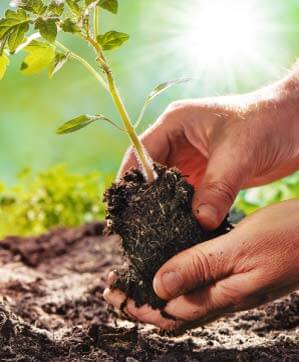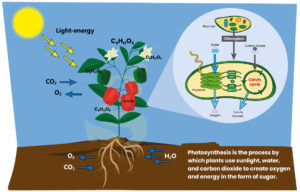
Brix in relation to crop health and quality
Brix in relatie tot gezondheid en kwaliteit van gewassen. De zoete wetenschap van Brix. Brix in relatie tot gezondheid en kwaliteit van gewassen. Brix-waarde verwijst
We are on holiday. Orders will be sent after October 2 Dismiss
More yield from better quality
All in just 5 products
25+ years of fertilizer experience
Better and cheaper
Easy to use
Growing tomatoes with liquid organic-mineral nutrients is an efficient and effective method of providing essential elements for robust plant growth and optimal fruit production. Thanks to the added biostimulants, your tomatoes will develop even better, Resulting in a bigger harvest with better quality fruits. This guide provides a step-by-step approach to growing tomatoes with these organo-mineral solutions, describing the benefits and key practices for a successful harvest.
Gen1:11 combines organic and mineral elements to provide a balanced and complete nutrient composition for tomatoes. By adding biostimulants, it promotes optimal plant development and strengthens resistance to diseases and stress. Moreover, it significantly improves fruit quality. Fruits are larger, firmer, contain more flavour and have a longer shelf life.
Gen1:11 does not use synthetic PGRs. More on this read here
The organic extracts, also known as biostimulants, help improve soil structure and promote better aeration and water retention. This results in improved root development, nutrient uptake and overall plant health. The biostimulants also accelerate nutrient uptake. The rapid uptake promotes robust growth, accelerates flowering and ultimately leads to higher yields. The biostimulants in Gen1:11 products play a crucial role in improving the plant's ability to resist stress factors such as drought, extreme temperatures and diseases, resulting in a more resilient crop.
Choose a well-drained substrate, such as a potting mix rich in organic matter, to provide a stable base for tomato plants. You can also opt for hydroponic growing. There are several hydroponic systems, each with its own pros and cons. Think hydro pellets, rockwool, coconut fibres, perlite, etc... We will restrict ourselves here to growing on soil.
First start by germinating your chosen seeds in a propagator. It is best to do this in a specially produced cutting & sowing soil. These are available at most garden centres. However, there are many other methods to germinate your seeds. Follow the instructions on the packaging of your seeds or follow your own preference. Once the seedlings have germinated a few true leaves, they are ready to be transplanted into your chosen substrate.
Carefully transplant the seedlings into larger pots or directly into garden soil. Water the seedlings with the prepared nutrient solution to promote seamless acclimatisation. Mix the liquid organo-mineral nutrients according to the product's instructions. Adjust the dilution ratio based on the growth stage of the plants and the desired nutrient concentration. At this stage, the fertilisers will mainly stimulate root growth. The added biostimulants will allow your plants to develop in a healthier and more stress-resistant manner. Now that you have repotted your seedlings, the next phase in the growth cycle begins. The vegetative phase

During this phase, mainly the roots will continue to develop and the plant will start to visibly increase in size. Focus on energetic development of the plant during this growth phase. Remove the lower leaves regularly to improve air circulation and prevent soil-borne diseases. Remove side shoots that compete with the main stem and focus energy on final fruit production. Check regularly for pests and diseases and address any problems immediately. By promoting a healthy vegetative phase, you lay the foundation for a productive tomato crop. Fertilise with the basic nutrients Gen1:11 Wholly Base and Gen1:11 Solid Green samen met de speciaal voor deze fase ontwikkelede Gen1:11 Rise Up. Doe dit volgens het groeischema zoals aangegeven bij de bijhorende vegetatieve fase.
The flowering phase is now beginning. The first buds begin to develop. During the flowering phase of tomato plants, prioritise phosphorus-rich nutrients to support robust flower and fruit development. In addition to liquid organic-mineral base fertilisers, use the specially developed fertiliser Gen1:11 Early Flower with biostimulants that stimulate bud formation. Ensure constant humidity, avoid water stress that can hamper bud formation. Sufficient sunlight, good pruning to improve air circulation and a balanced feeding schedule promote healthy flower and fruit production of your tomato plants.
To improve fruit ripening and grow large, juicy tomatoes, ensure adequate potassium (potassium). To do this, use the liquid organic-mineral fertilisers Gen1:11 Bloom Big with an increased potassium concentration to promote fruit development and flavour. Gen1:11 Bloom Big contains triacontanol, a natural growth stimulator for plants, which further enhances flowering and fruiting.
Support the plant by staking or caging it to control the weight of the developing fruit, prevent breakage and maintain good air circulation. Consider thinning out excessive foliage to direct energy towards fruiting. By applying these strategies, you will ensure robust tomato plants that produce large, tasty and juicy fruits during the ripening phase.
Check plants regularly for signs of nutrient deficiency or excess. Adjust the concentration or frequency of the nutrient solution based on plant health, growth stage and environmental conditions. Always water adequately and always make sure to add enough Calcium to prevent nose rot. This is a condition that can easily develop in tomatoes due to lack of moisture and calcium.
Growing with Gen1:11 organic-mineral nutrients offers a versatile and efficient approach to feeding plants throughout their life cycle. This allows you to optimise plant growth and ensure abundant, high-quality harvests. Remember to adjust methods based on specific growing conditions. Environmental influences can affect the needs of your plants.
Enjoy the fruits of your labour as you harvest ripe and tasty tomatoes. Harvesting means the successful completion of the growing cycle.
Create Your Own

Brix in relatie tot gezondheid en kwaliteit van gewassen. De zoete wetenschap van Brix. Brix in relatie tot gezondheid en kwaliteit van gewassen. Brix-waarde verwijst

Het endocannabinoïde systeem begrijpen Een korte handleiding voor CB1- en CB2-receptoren Het endocannabinoïde systeem (ECS) speelt een fundamentele rol bij het reguleren van verschillende fysiologische

Photosynthesis Photosynthesis is the process by which green plants, algae and some bacteria convert light energy into energy in the form of glucose. This process mainly takes place

7 handy tips to prepare for the new garden season Gardening tasks when the spring jitters strike: Spring is a time of renewal and

The development of hydroponic fertilisers through the ages The history of hydroponics is a story of innovation and perseverance, rooted in the quest of the

Creating a successful indoor grow involves more than just light and water. Here are 7 tips to boost your indoor garden.
Brix in relatie tot gezondheid en kwaliteit van gewassen. De zoete wetenschap van Brix. Brix in relatie tot gezondheid en kwaliteit van gewassen. Brix-waarde verwijst
Het endocannabinoïde systeem begrijpen Een korte handleiding voor CB1- en CB2-receptoren Het endocannabinoïde systeem (ECS) speelt een fundamentele rol bij het reguleren van verschillende fysiologische
Photosynthesis Photosynthesis is the process by which green plants, algae and some bacteria convert light energy into energy in the form of glucose. This process mainly takes place
7 handy tips to prepare for the new garden season Gardening tasks when the spring jitters strike: Spring is a time of renewal and
The development of hydroponic fertilisers through the ages The history of hydroponics is a story of innovation and perseverance, rooted in the quest of the
Creating a successful indoor grow involves more than just light and water. Here are 7 tips to boost your indoor garden.
Home » Benefits of Biostimulants in organo-mineral fertilizers in tomato growing

Because growing your own is a craft. It takes time, energy, focus, attention, maybe even love. At your own pace, in your own environment. You are the creator.